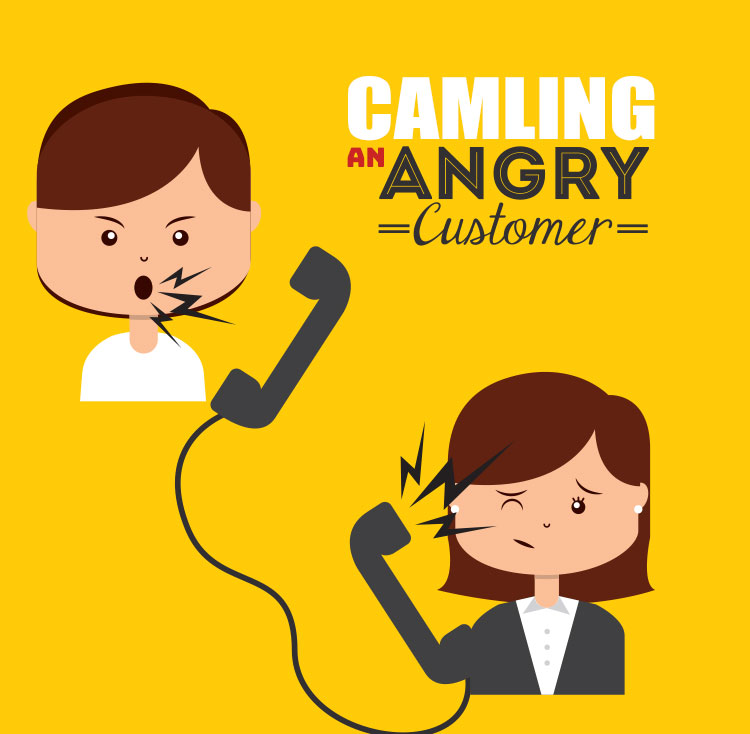Calming An Angry Customer
 Calming An Angry Customer
Calming An Angry Customer
Quick tips to help you diffuse anger and create calm with unhappy customers. Here is how to diffuse an angry or irate customer…
Top 6 Ways to Get An Angry Customer To Back Down
1. Apologize. An apology makes the angry customer feel heard and understood. It diffuses and anger and allows you to begin to re-establish trust. Not only that, but pilot studies have found that the mere act of apologizing has reduced lawsuits, settlement, and defense costs. You need to apologize to customers regardless of fault. Certainly, the apology needs to be carefully worded. Here’s an example of a sincere, yet careful apology:
“Please accept my sincere and unreserved apology for any inconvenience this may have caused you.”
2. Kill Them Softly With Diplomacy. This simple phrase has never failed me: “Clearly, we’ve upset you and I want you to know that getting to the bottom of this is just as important to me as it is to you.” When you say this, anger begins to dissipate. You’ve addressed the anger directly and non defensively and you haven’t been pulled into the drama of the attack.
3. Go into Computer Mode. Take on the formalities of a computer. Speak generally, without emotion, and don’t take the bait your angry or difficult customer is throwing you. Keep your words, tone, and attitude completely impersonal and neutral. This “computer mode” response deflects, diffuses, and disarms angry customers because you don’t add fuel to the fire by giving your difficult customer what they want -an emotional reaction. No matter how uncomfortable the verbal abuse is or how ridiculous it becomes, continue to respond without emotion. This tactic works because it is neutral and unexpected. The difficult customer wants to throw you off, make you lose control, and to get you to respond emotionally. When you fail to do each of these things, you actually regain control.
4. Give this question a shot: “Have I done something personally to upset you?… I’d like to be a part of the solution.” Of course, you know you haven’t done anything to upset the customer. You ask this question to force the angry customer to think about his behavior. Often, the mere asking of this question is enough to get the ballistic customer to begin to shift from the right brain to the left brain, where he can begin to listen and rationalize.
5. Show empathy – Empathy can be a powerful tool used to disarm an angry customer and show that you genuinely care about the inconvenience the customer has experienced. Expressing empathy is also good for YOU, as it helps you truly begin to see the problem from the customer’s perspective/and this perspective will help keep you from losing your cool when your customer gets hot. By letting customers know that you understand why they are upset, you build a bridge of rapport between you and them.
Here are some phrases that express empathy:
- “That must have been very frustrating for you.”
- “I realize the wait you encountered was an inconvenience.”
- “If I were in your shoes, I’m sure I’d feel just as you do.”
- “It must have been very frustrating for you have waited five days for your order and for that I am sorry.”
6. And finally, here’s a tip that works like magic. …. Show appreciation for the difficult person’s feedback. After your difficult customer has ranted and raved, you can regain control of the conversation by interjecting—not interrupting, but interjecting to thank them for taking the time to give you feedback. You can say something like:
- Thanks for being so honest.
- Thanks for taking the time to let us know how you feel.
- We appreciate customers who let us know when things aren’t right.
- Thanks for caring so much.
The reason this tip works so effectively is because the last thing your irate or unreasonable customer expects is for you to respond with kindness and gratitude. It’s a shock factor and many times you’ll find that your customer is stunned silent and this is exactly what you want.
When you do these things you’ll find that being on the receiving end of verbal abuse doesn’t have to be threatening or intimidating. You can come across as confident, composed and strong…and most importantly, you’ll regain control of the conversation.










